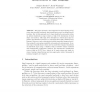Free Online Productivity Tools
i2Speak
i2Symbol
i2OCR
iTex2Img
iWeb2Print
iWeb2Shot
i2Type
iPdf2Split
iPdf2Merge
i2Bopomofo
i2Arabic
i2Style
i2Image
i2PDF
iLatex2Rtf
Sci2ools
ECCV
2004
Springer
2004
Springer
A Linguistic Feature Vector for the Visual Interpretation of Sign Language
Abstract. This paper presents a novel approach to sign language recognition that provides extremely high classification rates on minimal training data. Key to this approach is a 2 stage classification procedure where an initial classification stage extracts a high level description of hand shape and motion. This high level description is based upon sign linguistics and describes actions at a conceptual level easily understood by humans. Moreover, such a description broadly generalises temporal activities naturally overcoming variability of people and environments. A second stage of classification is then used to model the temporal transitions of individual signs using a classifier bank of Markov chains combined with Independent Component Analysis. We demonstrate classification rates as high as 97.67% for a lexicon of 43 words using only single instance training outperforming previous approaches where thousands of training examples are required.
Computer Vision | ECCV 2004 | Initial Classification Stage | Minimal Training Data | Single Instance Training | Stage Classification Procedure | Temporal Transitions |
| Added | 15 Oct 2009 |
| Updated | 15 Oct 2009 |
| Type | Conference |
| Year | 2004 |
| Where | ECCV |
| Authors | Richard Bowden, David Windridge, Timor Kadir, Andrew Zisserman, Michael Brady |
Comments (0)

